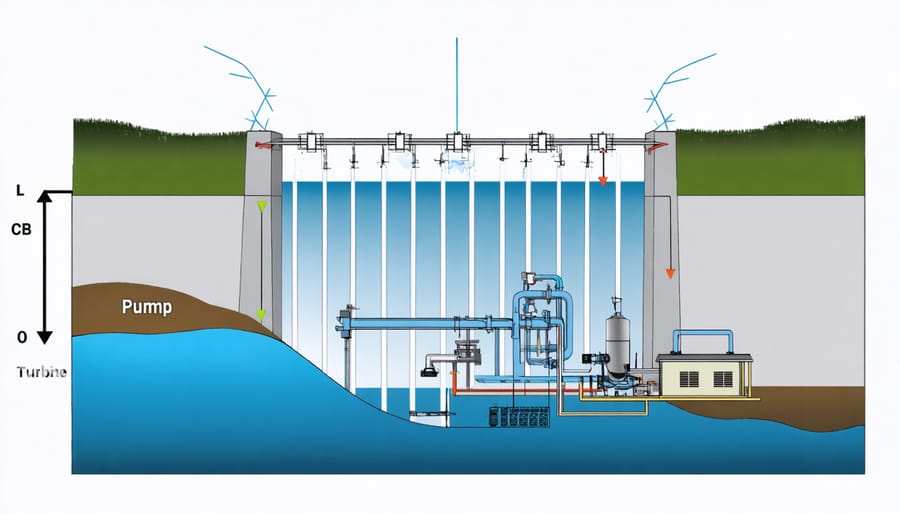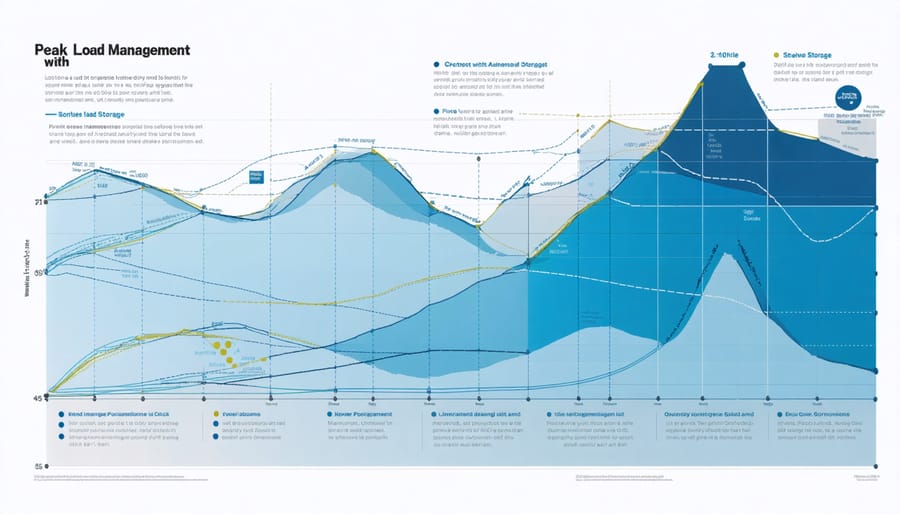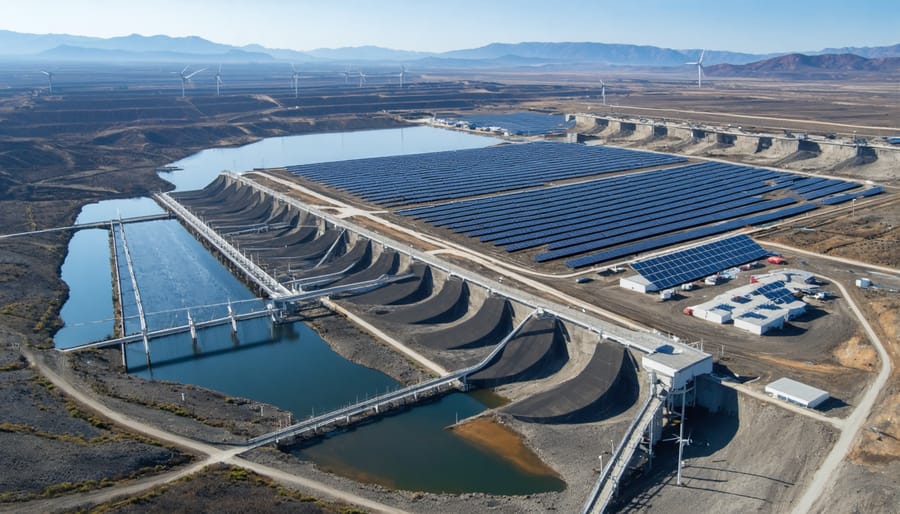How Pumped-Storage Hydropower Supercharges Industrial Energy Management

Pumped-storage hydropower stands at the forefront of modern energy storage technologies, offering a proven solution to Europe’s growing renewable energy integration challenges. By leveraging gravity and water’s potential energy, these systems function as massive batteries, storing excess power during low-demand periods and releasing it precisely when needed. Their remarkable efficiency—reaching up to 80%—combined with decades-long operational lifespans makes them invaluable assets in grid stabilization and peak demand management.
As Europe accelerates its transition toward renewable energy, pumped-storage facilities emerge as critical infrastructure components, capable of storing wind and solar power at unprecedented scales. These installations not only enhance grid reliability but also contribute significantly to reducing carbon emissions while maintaining consistent power supply across diverse geographical regions. With the European Union’s ambitious climate targets driving innovation in energy storage, pumped-storage hydropower represents a mature, scalable technology that bridges the gap between intermittent renewable generation and constant power demand.
The Power Behind Pumped Storage: Understanding the Basics
How Pumped Storage Works
Pumped-storage hydropower operates on a straightforward yet ingenious principle that leverages gravity and water movement. During periods of low electricity demand, typically at night, excess power from the grid drives powerful pumps to move water from a lower reservoir to an upper reservoir. This process effectively stores energy in the form of gravitational potential.
When electricity demand peaks, the stored water is released through turbines, flowing back to the lower reservoir. As the water descends, it drives the turbines, which are connected to generators that produce electricity. This process can be activated within minutes, making it highly responsive to grid demands.
The system operates in a closed loop, continuously cycling between pumping and generation modes. Modern facilities achieve efficiency rates of 70-85%, making them one of the most effective large-scale energy storage solutions available. The reservoirs can be natural lakes, artificial basins, or even underground caverns, adapting to various geographical conditions while maintaining the same operational principle.
Most facilities are designed to complete multiple cycles daily, providing crucial grid balancing services and supporting the integration of variable renewable energy sources like wind and solar.

Key System Components
A pumped-storage hydropower facility consists of several critical components working in harmony to enable efficient energy storage and generation. The upper and lower reservoirs form the system’s foundation, connected by powerful water conduits or tunnels. The upper reservoir serves as the primary storage mechanism, while the lower reservoir acts as a collection point during power generation.
The powerhouse, typically situated between the reservoirs, houses the reversible pump-turbines – sophisticated machines that can function both as pumps and generators. These units operate alongside motor-generators, which convert mechanical energy to electrical power during generation and vice versa during pumping operations.
Advanced control systems and grid connection infrastructure ensure seamless integration with the power network. Modern facilities incorporate variable-speed drives and cutting-edge monitoring equipment to optimize performance and respond rapidly to grid demands. Essential auxiliary systems include transmission lines, transformers, and protective equipment that safeguard the facility’s operation.
Environmental protection measures, such as fish screens and water quality monitoring systems, are integral components that ensure sustainable operation while maintaining ecological balance.
Industrial Applications and Benefits
Peak Load Management
Pumped-storage hydropower plays a crucial role in managing peak electricity demand across European power grids. During periods of high consumption, typically during morning and evening hours, these facilities can rapidly deploy stored energy within minutes to meet sudden spikes in demand. This quick-response capability helps maintain grid stability and prevents potential blackouts.
The system operates by releasing water from the upper reservoir precisely when additional power is needed, generating electricity that supplements the base power supply. This process is particularly valuable during peak business hours when industrial operations and household consumption create substantial demand on the grid.
What makes pumped storage especially effective is its large-scale storage capacity and ability to operate at full power for several hours. A single facility can provide hundreds of megawatts of power, effectively smoothing out demand fluctuations. This capability has become increasingly important with the growth of renewable energy sources, as pumped storage can compensate for the variable output of wind and solar installations.
In many European countries, pumped storage facilities work in tandem with smart grid systems to optimize power distribution and maintain consistent electricity prices during peak periods.

Grid Stability Support
Pumped-storage hydropower plays a crucial role in maintaining grid stability across European power networks. Acting as a massive energy buffer, these facilities respond within minutes to sudden changes in electricity demand or supply, helping to prevent blackouts and maintain consistent power quality. When renewable sources like wind and solar experience fluctuations, pumped-storage systems quickly step in to balance the grid.
The technology’s rapid response capability makes it particularly valuable for frequency regulation, voltage support, and load following. During peak demand periods, pumped-storage plants can release stored water through turbines almost instantly, providing the necessary power boost to maintain grid frequency at 50 Hz. Conversely, during low demand periods, excess electricity is used to pump water uphill, effectively storing energy for future use.
In countries like Austria and Switzerland, pumped-storage facilities have become essential grid stabilizers, supporting the integration of variable renewable energy sources while ensuring power quality remains within strict European standards. This reliability factor has made pumped-storage hydropower a cornerstone of modern grid management strategies, particularly in regions with high renewable energy penetration.
Cost Optimization
Pumped-storage hydropower systems demonstrate compelling financial benefits when properly implemented, particularly for organizations pursuing industrial energy independence. Initial investment costs typically range from €500-1,500 per kW of installed capacity, varying based on site conditions and system scale. However, these systems offer remarkable longevity, with operational lifespans exceeding 50 years and maintenance costs averaging just 2-3% of initial investment annually.
The return on investment (ROI) becomes particularly attractive when considering peak-load pricing differentials. During off-peak hours, electricity costs can be 60-70% lower than peak rates, allowing operators to generate significant savings through strategic energy arbitrage. Most installations achieve break-even within 8-12 years, depending on market conditions and operational efficiency.
Additional value streams come from grid stabilization services and renewable energy integration. Facilities can generate extra revenue by providing frequency regulation and backup power to grid operators, while also optimizing their renewable energy consumption. European energy markets increasingly reward such flexibility, with some regions offering specific incentives for storage solutions.
When factoring in carbon reduction benefits and potential government subsidies, the total cost of ownership becomes even more favorable. Modern installations typically achieve efficiency rates of 70-85%, significantly outperforming many alternative storage technologies in terms of long-term operational costs.
Integration with Renewable Energy

Solar and Wind Power Integration
Pumped-storage hydropower plays a crucial role in maximizing the potential of renewable energy sources, particularly wind and solar power. As these renewable sources generate electricity intermittently based on weather conditions, utility-scale energy storage becomes essential for maintaining grid stability and ensuring consistent power supply.
During periods of peak solar and wind generation, excess electricity powers the pumps to move water to the upper reservoir, effectively storing energy for later use. When renewable generation decreases, or demand increases, the stored water is released through turbines to generate electricity, providing a reliable backup power source.
This integration capability makes pumped storage particularly valuable in regions with high renewable energy penetration, such as Germany and Denmark. The system can respond to grid demands within minutes, offering quick-start flexibility that helps balance supply and demand fluctuations inherent to renewable sources.
For European grid operators, pumped storage facilities serve as essential tools for frequency regulation and voltage control, helping maintain power quality while accommodating increasing shares of renewable energy. This synergy between pumped storage and renewables supports the EU’s ambitious climate goals while ensuring reliable power delivery to homes and businesses.
Energy Management Strategies
Modern pumped-storage hydropower facilities employ sophisticated energy management strategies to maximize efficiency and revenue while supporting grid stability. The operation pattern typically follows daily electricity demand curves, pumping water during low-demand periods when electricity prices are lower and generating power during peak demand when prices are higher.
Advanced control systems utilize real-time data analytics and forecasting algorithms to optimize operation schedules. These systems consider multiple variables, including electricity market prices, grid demand patterns, renewable energy generation forecasts, and reservoir capacity constraints. The integration of smart grid technologies enables automated responses to grid frequency variations and demand fluctuations.
Operators implement strategic reservoir management to maintain optimal water levels for both immediate response capability and long-term sustainability. This includes careful monitoring of upper and lower reservoir conditions, weather patterns, and seasonal variations in electricity demand.
The coordination with renewable energy sources is particularly crucial in European markets. When wind or solar generation exceeds demand, pumped-storage facilities can quickly absorb excess power for later use. During periods of low renewable generation, these facilities can rapidly dispatch stored energy to maintain grid balance.
Modern facilities also employ predictive maintenance systems to ensure reliable operation while minimizing downtime. This proactive approach, combined with efficient scheduling algorithms, helps achieve optimal facility performance and maximizes return on investment while supporting broader grid stability objectives.
Implementation Considerations
Site Requirements
The successful implementation of pumped-storage hydropower facilities requires specific geographical and topographical conditions. Most critically, the site must feature two water reservoirs at different elevations, typically with a height difference of at least 100 meters. The upper reservoir is often situated on hillsides or mountain tops, while the lower reservoir can be natural lakes, rivers, or purpose-built basins.
Ideal locations combine suitable terrain with proximity to existing power infrastructure and transmission lines. The site should have sufficient water availability and appropriate geological conditions to support the construction of reservoirs and underground powerhouses. Rock stability is particularly crucial for ensuring long-term structural integrity.
Environmental considerations play a vital role in site selection. The location must allow for minimal impact on local ecosystems, wildlife corridors, and water resources. Additionally, the site should be accessible for construction equipment and maintenance vehicles, yet sufficiently isolated from residential areas to minimize noise and visual impact.
In Europe, suitable sites often exist in alpine regions, where natural elevation differences and existing water bodies can be utilized effectively, reducing construction costs and environmental disruption.
Regulatory Framework
The European Union has established comprehensive regulatory frameworks to support and govern pumped-storage hydropower facilities. The Water Framework Directive (WFD) serves as the primary legislation, ensuring environmental protection while promoting sustainable water resource management. Project developers must comply with Environmental Impact Assessment (EIA) requirements, which evaluate potential effects on local ecosystems and water bodies.
Member states implement additional national regulations, with varying requirements for licensing, operation permits, and grid connection protocols. Recent EU initiatives, including the Clean Energy Package, have recognized pumped-storage as a crucial element in energy storage infrastructure, streamlining approval processes for new facilities.
Operators must adhere to strict safety standards outlined in the Seveso III Directive and maintain compliance with grid codes established by ENTSO-E. Regular monitoring and reporting of operational data are mandatory, ensuring transparency and safety. The European Green Deal has further reinforced support for pumped-storage projects, offering enhanced funding opportunities through mechanisms like the Innovation Fund and Connecting Europe Facility.
For cross-border projects, operators must navigate multiple regulatory frameworks while ensuring alignment with EU-wide energy market regulations and transmission system requirements.
Environmental Impact
While pumped-storage hydropower offers significant renewable energy benefits, careful consideration must be given to its environmental impact of energy management. Modern facilities implement comprehensive mitigation strategies to protect local ecosystems. These include fish-friendly turbines, wildlife corridors, and controlled water flow management to maintain downstream habitat quality. Sustainable design practices focus on minimising land use impact and preserving natural water cycles. European operators typically conduct regular environmental assessments and maintain biodiversity monitoring programs. Advanced sediment management systems help prevent reservoir deterioration while protecting aquatic ecosystems. Through careful planning and ongoing environmental stewardship, modern pumped-storage facilities successfully balance energy storage needs with ecological preservation.
Pumped-storage hydropower stands as a cornerstone technology in Europe’s transition to a sustainable energy future. Its unique ability to provide large-scale energy storage, grid stability, and peak demand management makes it an invaluable asset for industrial applications. The technology’s proven track record of reliability, combined with its capacity to integrate seamlessly with renewable energy sources, positions it as a crucial element in achieving carbon reduction goals.
Looking ahead, the outlook for pumped-storage hydropower remains exceptionally promising. As European industries increasingly embrace renewable energy solutions, the demand for efficient energy storage systems continues to grow. Technological advancements are making these systems more efficient and cost-effective, while innovative designs are reducing environmental impact and improving operational flexibility.
For industrial users, the value proposition is clear: pumped-storage facilities offer a reliable solution for energy management, cost reduction, and sustainability goals. The technology provides a practical pathway to balance intermittent renewable energy sources, ensure power quality, and maintain operational continuity. With supportive regulatory frameworks across Europe and increasing investment in infrastructure, pumped-storage hydropower is well-positioned to play an even more significant role in the industrial energy landscape.
As we move towards a more sustainable future, the integration of pumped-storage systems with smart grid technologies and renewable energy sources will continue to evolve, offering enhanced benefits for industrial applications while supporting Europe’s broader energy transition goals.
Leave a Reply